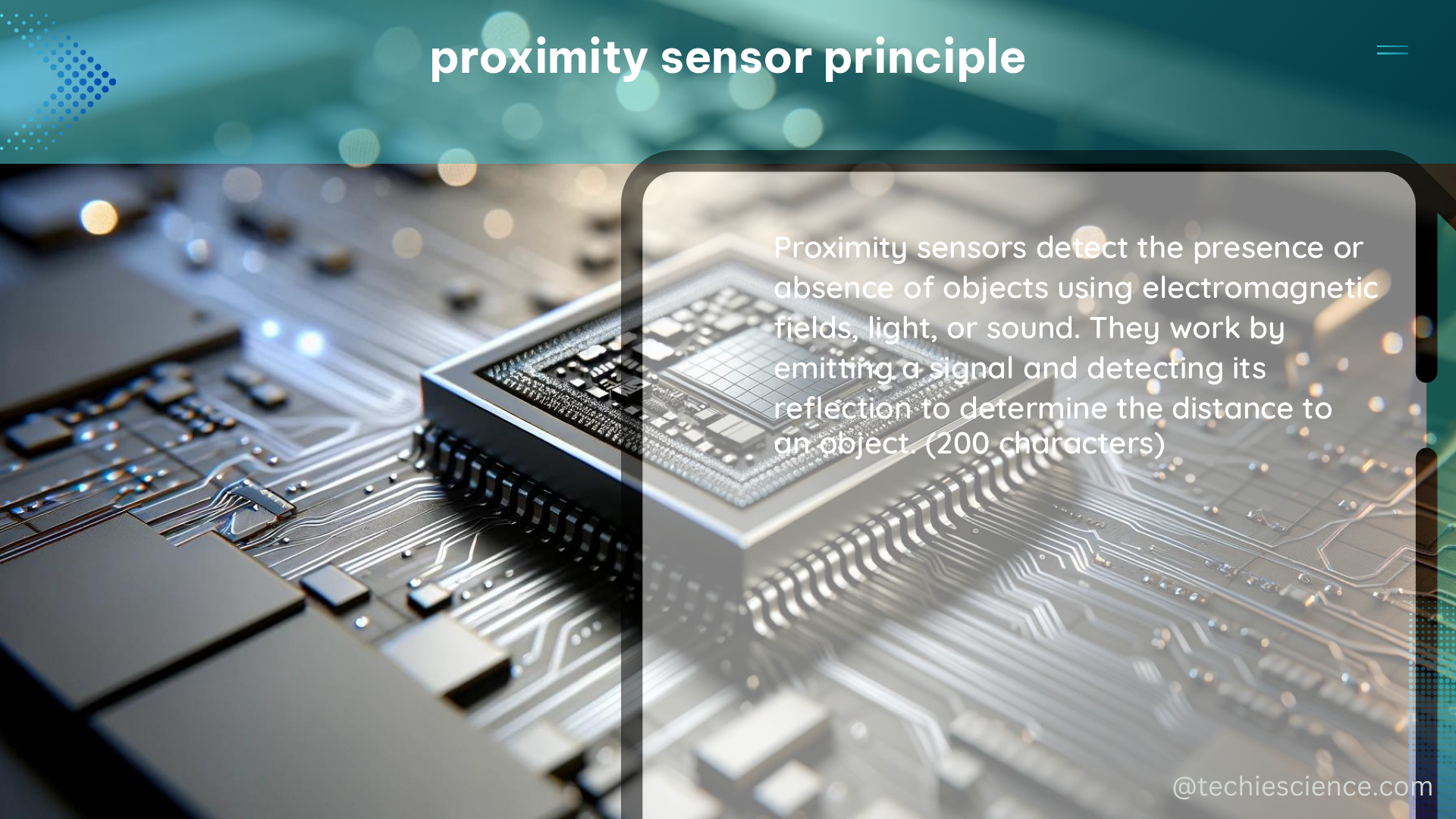The proximity sensor principle is a fundamental concept in the field of sensor technology, enabling the detection of objects without physical contact. This principle relies on the measurement of various physical quantities, such as magnetic fields, electric fields, acoustic waves, or light, to determine the presence or absence of an object within a specific range.
Understanding the Basics of Proximity Sensors
Proximity sensors are designed to convert the output of the sensing process into a measurable signal, which can then be used to determine the proximity of an object. The technical specifications of these sensors can vary significantly, depending on the type of sensor and its intended application.
Inductive Proximity Sensors
Inductive proximity sensors are commonly used to detect metallic objects. These sensors operate at frequencies ranging from a few hundred Hertz (Hz) to several Megahertz (MHz), with sensing distances typically ranging from a few millimeters (mm) to several centimeters (cm). The operating frequency and sensing distance of an inductive proximity sensor are directly related to the size and material of the target object, as well as the sensor’s design and construction.
Capacitive Proximity Sensors
Capacitive proximity sensors, on the other hand, can detect both metallic and non-metallic objects. These sensors have a sensing distance range that can vary from a few millimeters to several meters, depending on the frequency and capacitance of the sensor. The capacitance of the sensor changes when an object enters its sensing field, allowing the sensor to detect the presence of the object.
Optical Proximity Sensors
Optical proximity sensors utilize light, typically in the form of infrared (IR) or visible light, to detect the presence of an object. These sensors can have a wide range of sensing distances, from a few centimeters to several meters, depending on the power of the light source and the sensitivity of the photodetector. Optical proximity sensors are often used in applications where non-contact detection is required, such as in touchless user interfaces or object detection systems.
Ultrasonic Proximity Sensors
Ultrasonic proximity sensors use high-frequency sound waves to detect the presence of an object. These sensors emit a sound wave and measure the time it takes for the wave to reflect off an object and return to the sensor. The distance to the object can then be calculated based on the time of flight. Ultrasonic proximity sensors can have sensing distances ranging from a few centimeters to several meters, depending on the frequency and power of the sound waves.
Proximity Sensor Applications

Proximity sensors find a wide range of applications in various industries, including automotive, industrial, and consumer electronics.
Automotive Applications
In the automotive industry, proximity sensors are used in a variety of systems, such as:
– Anti-lock Braking Systems (ABS)
– Traction Control Systems (TCS)
– Electronic Stability Programs (ESP)
– Adaptive Cruise Control (ACC)
These sensors help to monitor and control the vehicle’s behavior, improving safety and performance.
Industrial Applications
In industrial settings, proximity sensors are used for:
– Object detection
– Positioning
– Sorting
– Process control
These sensors play a crucial role in automating and optimizing industrial processes, enhancing efficiency and productivity.
Consumer Electronics Applications
Proximity sensors are also found in consumer electronics, such as:
– Touchless user interfaces in smartphones and smart home devices
– Gesture recognition systems
– Automatic screen dimming or turning off in mobile devices
These sensors enable innovative and intuitive user experiences in consumer electronics.
Building a DIY Proximity Sensor
To build a DIY proximity sensor, you can use a variety of sensors and microcontrollers, such as Arduino or Raspberry Pi. Here’s a general outline of the steps involved:
-
Choose the Sensor Type: Depending on your application and the type of objects you want to detect, select an appropriate proximity sensor, such as an inductive, capacitive, optical, or ultrasonic sensor.
-
Select a Microcontroller: Choose a microcontroller that is compatible with the proximity sensor and has the necessary processing power and input/output (I/O) capabilities to handle the sensor’s output.
-
Connect the Sensor to the Microcontroller: Follow the manufacturer’s instructions to properly connect the proximity sensor to the microcontroller’s I/O pins.
-
Implement the Sensor Logic: Write the necessary code to read the sensor’s output, process the data, and determine the presence or absence of an object within the sensing range.
-
Calibrate the Sensor: Adjust the sensor’s parameters, such as sensitivity, threshold, or detection range, to optimize its performance for your specific application.
-
Integrate the Sensor into Your Project: Incorporate the proximity sensor into your larger project, such as an object detection system, a touchless interface, or a process control application.
By following these steps, you can build a customized DIY proximity sensor that meets your specific requirements and integrates seamlessly with your project.
Reference
- Sensorveillance Technology: The technology behind data-driven personal surveillance starts with sensors. (Duke Law Scholarship Repository, 2022)
https://scholarship.law.duke.edu/cgi/viewcontent.cgi?article=4144&context=dlj - Sensing and Sensor Fundamentals: A comprehensive overview of sensor technology and applications. (Springer, 2014)
https://link.springer.com/chapter/10.1007/978-1-4302-6014-1_2 - Proximity Sensors: A detailed guide to proximity sensor technology and applications. (Apress, 2014)
https://www.apress.com/gp/book/9781430260141

The lambdageeks.com Core SME Team is a group of experienced subject matter experts from diverse scientific and technical fields including Physics, Chemistry, Technology,Electronics & Electrical Engineering, Automotive, Mechanical Engineering. Our team collaborates to create high-quality, well-researched articles on a wide range of science and technology topics for the lambdageeks.com website.
All Our Senior SME are having more than 7 Years of experience in the respective fields . They are either Working Industry Professionals or assocaited With different Universities. Refer Our Authors Page to get to know About our Core SMEs.